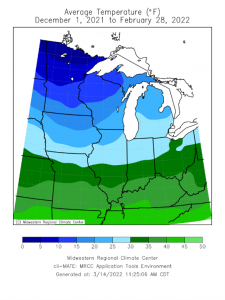Average winter temperatures in Illinois this past winter were very similar to what we saw during the winter of 2020-2021. (Figure 1). Warmer temperatures during the months of December, January and February favor increased survivability of the corn flea beetle and subsequently, the early season prevalence of Stewart’s Wilt, particularly in the southern half of the state.


Figure 1. Average winter temperatures of 2020-2021 and 2021-2022.
Corn flea beetles are the primary vector of Stewart’s Wilt. Erwinia stewartii, the bacterium that caused Stewart’s wilt, survives the winter in the gut of the corn flea beetle and the survival of the corn flea beetle is dependent on winter temperatures. Warmer winters result in greater survivorship of corn flea beetles, thus increasing the potential for Stewart’s wilt, while colder temperatures adversely affect it. Using the average temperatures of December, January, and February, the potential for Stewart’s wilt can be predicted (Table 1).
Table 1. Projected risk of Stewart’s wilt based on the average temperatures of December, January, and February.
| Average temperature of December, January, & February | Probability of early season wilt | Probability of late season blight |
| <27° F | Absent | Trace, at most |
| 27-30° F | Light | Light to Moderate |
| 30-33° F | Moderate | Moderate to Severe |
| >33° F | Severe | Severe |
Corn flea beetles become active in the spring when temperatures rise above 65°F, and they feed on and transmit Stewart’s wilt bacteria to seedling corn plants. The bacterium can spread systemically throughout the plant. Although most commercial field corn hybrids are resistant to Stewart’s wilt, the disease is still a concern for susceptible seed corn inbreds and many sweet corn hybrids.
There are two phases of Stewart’s wilt: the seedling wilt phase and the leaf blight phase. The seedling wilt stage occurs when seedlings become infected at or before the V5 stage. The vascular system becomes plugged with bacteria, causing the seedling to wilt, become stunted, and die. Infections of older corn plants usually result in the development of the leaf blight phase of Stewart’s wilt. This phase is characterized by long, yellow to chlorotic streaks with wavy margins along the leaves. When the late infection phase or “leaf blight phase” of Stewart’s wilt occurs after tasseling, it is generally not a concern in sweet corn because ears are harvested before damage occurs.

Based on the recent winter temperatures from the Midwest Regional Climate Center, estimates of early season Stewart’s wilt are shown in Table 2. Remember, however, that these are only predictions; numbers of surviving corn flea beetles are not known.
Table 2. Early season Stewart’s wilt predictions, 2022
| Location | Average temperature December 2021-February 2022 | Early Season Wilt |
| Freeport | 23° F | Absent |
| DeKalb | 24° F | Absent |
| Monmouth | 26° F | Absent |
| Peoria | 28° F | Light/Moderate |
| Champaign | 30° F | Light/Moderate |
| Springfield | 30° F | Moderate |
| Newton | 35° F | Severe |
| Belleville | 35° F | Severe |
| Mt. Vernon | 37° F | Severe |
| Carbondale | 38° F | Severe |
| Dixon Springs | 38° F | Severe |
